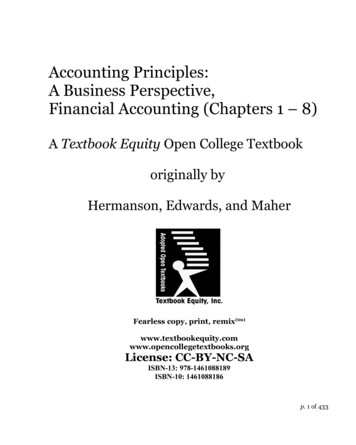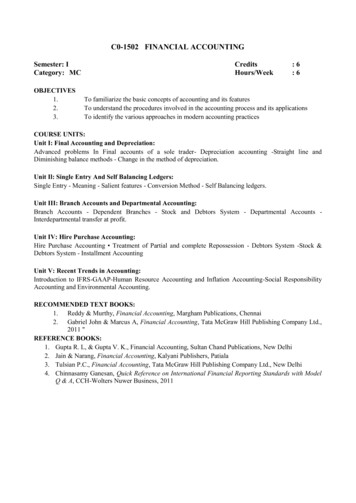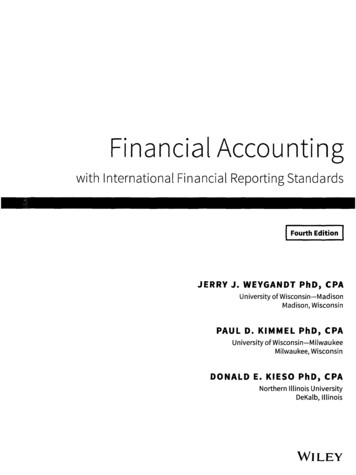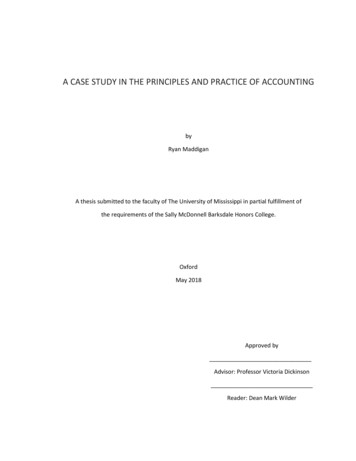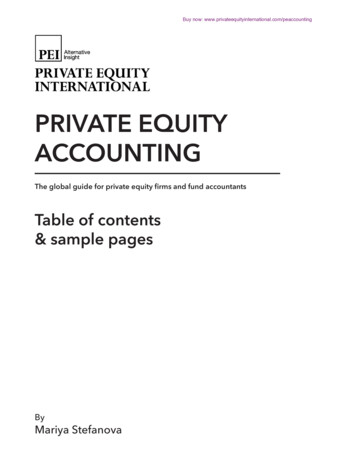
Transcription
Accounting Principles:A Business PerspectiveVolume 1 Financial Accounting
Accounting Principles:A Business PerspectiveFirst Global Text Edition, Volume 1Financial AccountingJames Don Edwards, PhD, D.H.C.J.M. Tull Professor Emeritus of AccountingTerry College of BusinessUniversity of GeorgiaRoger H. Hermanson, PhDRegents Professor Emeritus of AccountingErnst & Young-J. W. Holloway Memorial Professor EmeritusGeorgia State UniversityFunding for the first Global Text edition was provided byEndeavour International Corporation, Houston, Texas, USA.The Global Text Project is funded by the Jacobs Foundation, Zurich, Switzerland.This book is licensed under a Creative Commons Attribution 3.0 License
Acknowledgments for the Global Text First Edition:Revision Editor: Donald J. McCubbrey, PhDClinical Professor, Daniels College of BusinessUniversity of DenverLife member, American Institute of Certified Public AccountantsRevision AssistantsEmily AndersonKyle BlockAssistant EditorJackie SharmanAssociate EditorMarisa DrexelConversion SpecialistVarun Sharma
This book is licensed under a Creative Commons Attribution 3.0 LicenseTable of ContentsAccounting principles:A business perspective.6The accounting environment.18Accounting defined.19Financial accounting versus managerial accounting.23Development of financial accounting standards.25Ethical behavior of accountants.271. Accounting and its use in business decisions.30Forms of business organizations.31Types of activities performed by business organizations.33Financial statements of business organizations.33The financial accounting process.37Analyzing and using the financial results—the equity ratio.472. Recording business transactions.68The account and rules of debit and credit.69The accounting cycle.75The journal.76The ledger.79The accounting process in operation.803. Adjustments for financial reporting.123Cash versus accrual basis accounting.124Classes and types of adjusting entries.127Adjustments for deferred items.129Adjustments for accrued items.1374. Completing the accounting cycle.159The accounting cycle summarized.160The work sheet.160Preparing financial statements from the work sheet.166Journalizing adjusting entries.167The closing process.168Accounting systems: From manual to computerized.174A classified balance sheet.179Analyzing and using the financial results — the current ratio.1855. Accounting theory.210Traditional accounting theory.211Other basic concepts.213The measurement process in accounting.214The major principles.215Modifying conventions (or constraints).221The financial accounting standards board's conceptual framework project.224Objectives of financial reporting.224Qualitative characteristics.226Recognition and measurement in financial statements.2316. Merchandising transactions.250Introduction to inventories and the classified income statement.250Two income statements compared— Service company and merchandising company.251Accounting Principles: A Business Perspective4A Global Text
Sales revenues.252Cost of goods sold.258Classified income statement.267Analyzing and using the financial results—Gross margin percentage.2717. Measuring and reporting inventories.296Inventories and cost of goods sold.297Determining inventory cost.300Departures from cost basis of inventory measurement.320Analyzing and using financial results—inventory turnover ratio.3258. Control of cash.353Internal control.354Controlling cash.361The bank checking account.364Bank reconciliation.369Petty cash funds.374Analyzing and using the financial results—The quick ratio.3779. Receivables and payables.395Accounts receivable.396Current liabilities.405Notes receivable and notes payable.412Short-term financing through notes payable.417Analyzing and using the financial results—Accounts receivable turnover and number of days' sales inaccounts receivable.42010. Property, plant, and equipment.437Nature of plant assets.438Initial recording of plant assets.439Depreciation of plant assets.443Subsequent expenditures (capital and revenue) on assets.456Subsidiary records used to control plant assets.459Analyzing and using the financial results—Rate of return on operating assets.46111. Plant asset disposals, natural resources, and intangible assets.478Disposal of plant assets.479Intangible assets.491Analyzing and using the financial results—Total assets turnover.49912. Stockholders' equity: Classes of capital stock.519The corporation.520Documents, books, and records relating to capital stock.524Par value and no-par capital stock.525Other values commonly associated with capital stock.526Capital stock authorized and outstanding.527Classes of capital stock.528Types of preferred stock.528Balance sheet presentation of stock.531Stock issuances for cash.532Capital stock issued for property or services.533Balance sheet presentation of paid-in capital in excess of par (or stated) value—Common or preferred.534Analyzing and using the financial results—Return on average common stockholders' equity.5365
This book is licensed under a Creative Commons Attribution 3.0 License13. Corporations: Paid-in capital, retained earnings, dividends, and treasury stock.557Paid-in (or contributed) capital.558Retained earnings.559Paid-in capital and retained earnings on the balance sheet.559Retained earnings appropriations.567Statement of retained earnings.568Statement of stockholders' equity.569Treasury stock.569Net income inclusions and exclusions.573Analyzing and using the financial results—Earnings per share and price-earnings ratio.57714. Stock investments.598Cost and equity methods.599Consolidated balance sheet at time of acquisition.607Accounting for income, losses, and dividends of a subsidiary.611Consolidated financial statements at a date after acquisition.612Uses and limitations of consolidated statements.615Analyzing and using the financial results—Dividend yield on common stock and payout ratios.61615. Long-term financing: Bonds.633Bonds payable.634Bond prices and interest rates.640Analyzing and using the financial results—Times interest earned ratio.65216. Analysis using the statement of cash flows.673Purposes of the statement of cash flows.674Uses of the statement of cash flows.675Information in the statement of cash flows.675Cash flows from operating activities.677Steps in preparing statement of cash flows.679Analysis of the statement of cash flows.685Analyzing and using the financial results—Cash flow per share of common stock, cash flow margin, and cashflow liquidity ratios.691Appendix: Use of a working paper to prepare a statement of cash flows.69317. Analysis and interpretation of financial statements.721Objectives of financial statement analysis.722Sources of information.724Horizontal analysis and vertical analysis: An illustration.725Trend percentages.729Ratio analysis.73018. Managerial accounting concepts/job costing.777Compare managerial accounting with financial accounting.778Merchandiser and manufacturer accounting: Differences in cost concepts.779Financial reporting by manufacturing companies.782The general cost accumulation model.786Job costing.787Predetermined overhead rates.793Accounting Principles: A Business Perspective6A Global Text
This book is licensed under a Creative Commons Attribution 3.0 LicenseAccounting principles:A business perspectiveEighth editionRoger H. Hermanson, PhD, CPA (Georgia State University, USA)James D. Edwards, PhD, D.H.C., CPA (The University of Georgia, USA)Michael W. Maher, PhD, CPA (University of Notre Dame, USA)About the authorsProfessor Roger H. Hermanson, PhD, CPARegents Professor Emeritus of Accounting and Ernst & Young-J. W. Holloway Memorial Professor Emeritus atGeorgia State University. He received his doctorate at Michigan State University in 1963 and is a CPA in Georgia.Professor Hermanson taught and later served as chairperson of the Division of Accounting at the University ofMaryland. He has authored or coauthored approximately one-hundred articles for professional and scholarlyjournals and has coauthored numerous editions of several textbooks, including Accounting Principles, FinancialAccounting, Survey of Financial and Managerial Accounting, Auditing Theory and Practice, Principles ofFinancial and Managerial Accounting, and Computerized Accounting with Peachtree Complete III. He also hasserved on the editorial boards of the Journal of Accounting Education, New Accountant, Accounting Horizons, andManagement Accounting. Professor Hermanson has served as co-editor of the Trends in Accounting Educationcolumn for Management Accounting. He has held the office of vice president of the American AccountingAssociation and served on its Executive Committee. He was also a member of the Institute of ManagementAccountants, the American Institute of Certified Public Accountants, and the Financial Executives Institute.Professor Hermanson has been awarded two excellence in teaching awards, a doctoral fellow's award, and aDistinguished Alumni Professor award; and he was selected as the Outstanding Faculty Member for 1985 by theFederation of Schools of Accountancy. He has served as a consultant to many companies and organizations. In1990, Professor Hermanson was named Accounting Educator of the Year by the Georgia Society of CPAs. His wife'sname is Dianne, and he has two children, Dana and Susan, both of whom are accounting professors.Professor James D. Edwards, PhD, DHC, CPAJ. M. Tull Professor Emeritus of Accounting in the Terry College of Business at the University of Georgia. He is agraduate of Louisiana State University and has been inducted into the Louisiana State University AlumniFederation's Hall of Distinction. He received his MBA from the University of Denver and his PhD from theUniversity of Texas and is a CPA in Texas and Georgia. He has served as a professor and chairman of theDepartment of Accounting and Financial Administration at Michigan State University, a professor and dean of theGraduate School of Business Administration at the University of Minnesota, and a Visiting Scholar at OxfordUniversity in Oxford, England.Professor Edwards is a past president of the American Accounting Association and a past national vice presidentand executive committee member of the Institute of Management Accountants. He has served on the board ofdirectors of the American Institute of Certified Public Accountants and as chairman of the Georgia State Board ofAccountancy. He was an original trustee of the Financial Accounting Foundation, the parent organization of theFASB, and a member of the Public Review Board of Arthur Andersen & Co.Accounting Principles: A Business Perspective7A Global Text
Accounting principles:A business perspectiveHe has published in The Accounting Review, The Journal of Accountancy, The Journal of AccountingResearch, Management Accounting, and The Harvard Business History Review. He is also the author of Historyof Public Accounting in the United States. He has served on various American Institute of Certified PublicAccountants committees and boards, including the Objectives of Financial Statements Committee, Standards ofProfessional Conduct Committee, and the CPA Board of Examiners. He was the managing editor of the centennialissue of The Journal of Accountancy.In 1974, Beta Alpha Psi, the National Accounting Fraternity, selected Professor Edwards for its first annualOutstanding Accountant of the Year award. This selection is made from industry, government, and educationalleaders. In 1975, he was selected by the American Accounting Association as its Outstanding Educator.He has served the AICPA as president of the Benevolent Fund, chairman of the Awards Committee, member ofthe Professional Ethics Committee and Program for World Congress of Accountants. He was on the EducationStandards Committee of the International Federation of Accountants and the Committee on Planning for theInstitute of Management Accountants. He was the director of the Seminar for Management Accountants-FinancialReporting for the American Accounting Association. He is also a member of the Financial Executives Institute.He received the 1993 AICPA Gold Medal Award, the highest award given by the Institute. A Doctor HonorisCausa (Honorary Doctorate) from the University of Paris was awarded to him in 1994. He is the first accountant toreceive this distinction in France. The Academy of Accounting Historians awarded him the 1994 Hourglass Awardwhich is the highest international honor in the field of Accounting History. He was inducted into the Ohio StateUniversity Accounting Hall of Fame in 2001. His wife's name is Clara, and he has one son, Jim.Professor Michael W. Maher, PhD, CPAProfessor of management at the University of California at Davis. He is a graduate of Gonzaga University (BBA)and the University of Washington (MBA, PhD). Before going to the University of California at Davis, he taught atthe University of Michigan and the University of Chicago. He also worked on the audit staff at Arthur Andersen &Co. and was a self-employed financial consultant for small businesses while attending graduate school.Professor Maher is the coauthor of two leading textbooks, Cost Accounting and Managerial Accounting. He hascoauthored several additional books and monographs, including Internal Controls in US Corporations (FinancialExecutives Research Foundation, 1980); and Management Incentive Compensation Plans (National Association ofAccountants, 1986). His articles have appeared in Management Accounting, The Journal of Accountancy, TheAccounting Review, The Journal of Accounting Research, Financial Executive, and The Wall Street Journal,among others.For his research on internal controls, Professor Maher was awarded the American Accounting AssociationCompetitive Manuscript Award and the AICPA Notable Contribution in Literature Award. He has also beenawarded the American Tax Association Manuscript Award. From the students at the Graduate School ofManagement, University of California, Davis, he has received the Annual Outstanding Teacher Award three timesand twice received a special award for outstanding service. In 1989, Gonzaga University honored Maher with itsOutstanding Alumni Merit Award.8
This book is licensed under a Creative Commons Attribution 3.0 LicensePrefacePhilosophy and purposeImagine that you have graduated from college without taking an accounting course. You are employed by acompany as a sales person, and you eventually become the sales manager of a territory. While attending a salesmanagers' meeting, financial results are reviewed by the Vice President of Sales and terms such as gross marginpercentage, cash flows from operating activities, and LIFO inventory methods are being discussed. The VicePresident eventually asks you to discuss these topics as they relate to your territory. You try to do so, but it isobvious to everyone in the meeting that you do not know what you are talking about.Accounting principles courses teach you the "language of business" so you understand terms and concepts usedin business decisions. If you understand how accounting information is prepared, you will be in an even strongerposition when faced with a management decision based on accounting information.The importance of transactions analysis and proper recording of transactions has clearly been demonstrated insome of the recent business failures that have been reported in the press. If the financial statements of an enterpriseare to properly represent the results of operations and the financial condition of the company, the transactionsmust be analyzed and recorded in the accounts following generally accepted accounting principles. The debits andcredits are important not only to accounting majors but also to those entering or engaged in a business career tobecome managers because the ultimate effects of these journal entries are reflected in the financial statements. Ifexpenses are reported as assets, liabilities and their related expenses are omitted from the financial statements, orreported revenues are recorded prematurely or do not really exist, the financial statements are misleading. Thefinancial statements are only useful and meaningful if they are fair and clearly represent the business events of thecompany.We wrote this text to give you an understanding of how to use accounting information to analyze businessperformance and make business decisions. The text takes a business perspective. We use the annual reports of realcompanies to illustrate many of the accounting concepts. You are familiar with many of the companies we use, suchas The Limited, The Home Depot, and Coca-Col
Accounting, Survey of Financial and Managerial Accounting, Auditing Theory and Practice, Principles of Financial and Managerial Accounting, and Computerized Accounting with Peachtree Complete III. He also has served on the editorial boards of the Journal of Accounting Education,
